The Impact of a More Acidic Environment on Marine Microbes due to Ocean Acidification
Abstract:
As climate change has become an evermore prevalent issue, the consequence of ocean acidification has become increasingly alarming in terms of the potential effects on the environment, Marine ecosystems are at a great risk of decreasing significantly in biodiversity because many species are struggling and will continue to struggle adapting to the increasingly acidic environment (Bennett). Carbonate is a “building block†of the Earth’s oceans, and with the increased CO2 levels in the ocean, the average pH is increasing as the carbonate ion levels are decreasing. The current ocean pH is 8.1, but is expected to decrease by 2100 to 7.7 - 7.8 (Bennett), which would make the ocean’s the most acidic they have ever been. However, not only can this impact the ocean’s composition, but the microbial species who inhabit the waters.
Detrimental consequences for the earth may arise if marine microorganisms are not able to readily adapt to decreased pH levels resulting from ocean acidification. Marine microbes are the major primary producers in the earth’s oceans, making them also the primary, making them arguably the most crucial aspect of marine ecosystems (Hall). Therefore, this experiment delves into trying to examine the possible impact ocean acidification (and thus climate change) would have on marine microorganisms. Samples were taken from Mercer Lake. The samples were subcultured, isolated and grown on agar plates. The growth of Bacillus pseudomycoides, Bacillus paranthracis, and Bacillus tropicus was examined under varying concentrations of carbonic acid.
The greatest number of colonies were observed in slightly basic environments with a decrease in microbial growth in environments with a pH less than 7. Such conclusions are significant because as CO2 levels continue rising and the pH of the ocean decreases, it will have a negative impact on microbial populations which are beneficial to the proper balance of ecosystem functionality.
Bennett, J. (Ed.). (2018, April). Ocean Acidification. Retrieved February 20, 2020, from
https://www.google.com/amp/ocean.si.edu/ocean-life/invertebrates/ocean-acidification?amp.
Hall, D., Santoro, A., & Laperriere, S. (2019, July 24). Marine Microbes. Retrieved March 4, 2020, from
https://ocean.si.edu/ocean-life/microbes/marine-microbes.
Bibliography/Citations:
No additional citationsAdditional Project Information
Research Plan:
A. How will the decrease in pH of oceans due to climate change impact marine microorganisms crucial to the earth’s marine ecosystems?
B. Determine, qualitatively, how the reproduction of marine microorganisms is affected by the decrease in pH.The expected outcome is that the decrease in pH will result in a decrease in the reproduction and abundance of marine microbes because the increased level of carbon dioxide that causes ocean acidification breaks down carbonate, which is a building block of oceans.
C. Procedure
- Obtain fresh water sample from local lake (Mercer County Lake)
- Collect water in sterile cups
- Record the water temperature and pH
- Plate 200 μL of the samples onto separate nutrient agar plates
- Incubate the plates at room temperature for two days
- Isolate pure colonies
- Use a sterile inoculating loop to gently scrape off a colony to isolate it
- Swish off bacteria from the inoculating loop in 10 mL of nutrient (luria) broth
- Incubate the cultures in a shaking incubator at room temperature for two days
- Repeat step 2 and step 3 until qualitative data shows pure colonies
- Send the plate with the isolated colonies to GENEWIZ for sequencing
D. Bibliography (APA)
Abatenh, E., Gizaw, B., Tsegaye, Z., Tefera, G. (2018, January 18). Microbial Function on Climate
Change - A Review. Retrieved from
https://www.ncbi.nlm.nih.gov/pmc/articles/PMC3686211/.
Coelho, F.J.R.C., Santos, A.L., Coimbra, J., Almeida, A., Cunha, A., Cleary, D.F.R., Calado, R., Gomes, N.C.M.
(2013, April 23). Interactive effects of global climate change and pollution on marine
microbes: the way ahead. Retrieved
https://www.ncbi.nlm.nih.gov/pmc/articles/PMC3686211/.
Currie, A.R., Tait, K., Parry, H., Francisco-Mora, B., Hicks, N., Osborn, A.M., Widdicombe, S.,
Stahl, H. (2017, August 22). Marine Microbial Gene Abundance and Community
Composition in Response to Ocean Acidification and Elevated Temperature in Two
Contrasting Coastal Marine Sediments. Retrieved from
https://www.ncbi.nlm.nih.gov/pmc/articles/PMC5572232/
Rui, J., Li, J., Wang, S., An, J., Liu, W., Lin, Q., Yang, Y., He, Z., Li, X. (n.d.) Responses of
Bacterial Communities to Simulated Climate Changes in Alpine Meadow Soil of the
Qinghai-Tibet Plateau. Retrieved from https://aem.asm.org/content/81/17/6070.
Shomu’s Biology. (2012, October 31). 16s rRNA and its use. Retrieved from
E. Potentially Hazardous Biological Agents
The investigated bacteria are unknown species until sequencing, therefore some could be potentially hazardous. Therefore, the species will be contained by being grown on sterile plates while also being isolated using sterile technique. Once the experiment is complete, the plates will be taped and then placed in the trash.

